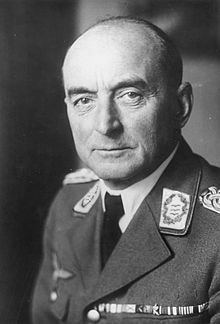Years of service 1898–1942 Name Leonhard Kaupisch | ||
 | ||
Battles/wars Wars:World War IWorld War IICampaigns:September CampaignOperations:Operation WeserubungBattles:Battle of GdyniaBattle of Kepa Oksywska Battles and wars World War II, Invasion of Poland, Operation Weserubung, Battle of Gdynia, Battle of Kepa Oksywska Similar People William Wain Prior, Nikolaus von Falkenhorst, Christian X of Denmark, Fedor von Bock, Zygmunt Bohusz‑Szyszko | ||
Leonhard Kaupisch (1 September 1878 – 26 September 1945) was a German General der Flieger whose military service spanned almost five decades. Kaupisch is most well known for his actions during World War II, primarily as Military Commander of Denmark.
Contents
Early career
Kaupisch entered the army in 1898 and was promoted to Leutnant in 1899. From 1907 to 1909 he completed his training at the war academy in Lichterfelde and was then appointed to Oberleutnant. From 1911 he served with General Staff, in Berlin. In 1914 he was promoted to the rank of Hauptmann.
World War I
During World War I Kaupisch was used at different positions in the General Staff and rose gradually in the rates and in 1917 promoted to Major. He also received the Iron Cross 2nd Class and the Knight's Cross of House Order of Hohenzollern in the same period.
Interbellum
After World War I, Kaupisch moved into the new Reichswehr and was assigned to the Gruppenkommando 2 at Kassel. In 1923 he took command of the 7. (Bayer.) Artillerie-Regiment and was promoted to Oberstleutnant. From there he moved to artillery school in Juterbog where in 1927 he was appointed Oberst. He continued his career in artillery until he departed in 1932 from his post with the level of Generalleutnant.
April 1, 1934 he joined the Luftwaffe where in December 1935 he was appointed General der Flieger. By the end of March 1938 he departed from the Luftwaffe, but in early 1939 he again joined the army.
World War II
In mid-September 1939, Kaupisch was military governor of Danzig-West Prussia. In late 1939, his staff was adopted to Hoheres Kommando XXXI. It was as head of this command that he April 9, 1940 led Operation Weserubung Sud, forcing the occupation of Denmark. The OPROP! leaflets with a call to refrain from resistance which German planes dropped during the early morning were signed by Kaupisch.
Until June 1, 1940 he was Supreme Commander of the German troops in Denmark. He then continued in the army reserve as general of artillery until his retirement on April 10, 1942.
Post–war
Anticipating the imminent end of the Third Reich, Kaupisch and his family left their home in the wealthy neighbourhood of Eichkamp in Westend, Berlin and settled in Bad Berka, a spa town lying approximately 10 km south of Weimar. There, he lived quietly the war's end and the capitulation of Germany in May 1945, whereupon the city was captured by American troops. That summer, he was also interviewed by a Danish journalist who noted that the retired General had adapted to the peacetime lifestyle. When, however, the region of Weimar became part of the Soviet zone of occupation, the aging Kaupisch was arrested and force–marched in the scorching heat to Weimar. His condition worsened by the rough conditions of his captivity, and although his wife was allowed to take care of him at the POW camp, Kaupisch died a few weeks after his 67th birthday, on 26 September 1945.
